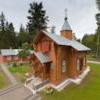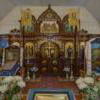Panoramas:
 |  |
Date of construction: In 1868 at Mereküla in the name of the Kazan Icon of the Mother of God. Church building was carried to Narva-Jőesuu in 1948.
Date of consecration: 28 August 1948 by bishop Isidore (Bogoyavlensky) of Tallinn and Estonia
The holiday village of Narva-Jõesuu is located on the left-hand bank of the Narva River at the place where it flows into the gulf of Finland. The old German name of the town is Hungersburg. The Russian name of the town is Ust-Narva, and since 1873 it had developed as a summer holiday destination of the Petersburg and Moscow aristocracy. The town became known as a sea resort, a pearl of the Baltic coast. Lots of famous writers, artists and musicians rested in the town. In Narva-Jõesuu and its vicinities rested I. Repin, I. Shishkin, P. Chaikovsky, N. Leskov, I. Goncharov and others. From the most influential Moscow and Petersburg summer residents, and also local residents, the building committee was formed and a special petition was sent to the church authorities with the request to build a new church. The money for the church came not only from the local people and holiday makers. Emperor Alexander III donated 5000 rubles, the city of Narva — 6000 rubles and the land for the church; the Most Holy Synod gave 2000 rubles, the Baltic Orthodox Brotherhood — 2000 rubles.
The solemn ceremony of laying the first brick took place on August 5, 1890 by Bishop Arseny (Bryantsev) of Riga and Mitav in the presence of Emperor Alexander III and Empresses Maria Feodorovna and other members of the Imperial family. The Emperor placed the first brick and a coin in the foundation of the church. The church was consecrated on August 17, 1893 in the name of Saint Prince Vladimir by Bishop Arseny (Bryantsev). The five-cupola church towered on the left-hand bank of the Narva River and was built under the direction of architect A. Ivanov in Russian style, with a stone belfry and covered arcades for religious processions in bad weather. The church was blown up during the retreat of the German armies in 1944.
A general meeting of the Orthodox parish took place in December, 1945 and it was decided to ask the authority to transport the Kazan church from Mereküla village to the place of the destroyed church. At the beginning of 1946 the blessing of Archbishop Pavel (Dmitrovsky) of Tallinn and Estonian was received and the authorities allowed the building of the church, next to the city market, where it stands now. The small wooden church in Mereküla village was built in 1867 and consecrated in the name of the Kazan icon of the Mother of God. The inspirer of the building of the church was a Petersburg priest Alexander Gumilevsky who had ministered in Narva in 1866-1867. The church was built from timbers covered with tinplates and gilded on edgings. The history of its building is described by N. Leskov in his story "Shelter". The church was attributed to the Narva Transfiguration cathedral. During the war Mereküla village was burned down, and the church was saved by a miracle. In 1947 the church was transported to a new place in Narva-Jõesuu. Unfortunately, the carved wooden cupola and a part of the carved the roof were lost. On August 28, 1948 Bishop Isidor (Bogoyavlensky) of Tallinn and Estonia consecrated the church in the name of Saint Prince Vladimir.
Address: Vabaduse 63, 29023 Narva-Jőesuu, Ida-Virumaa